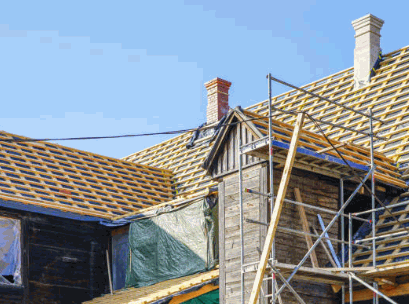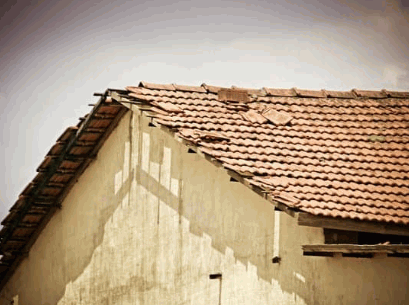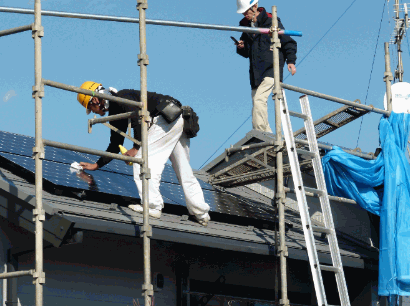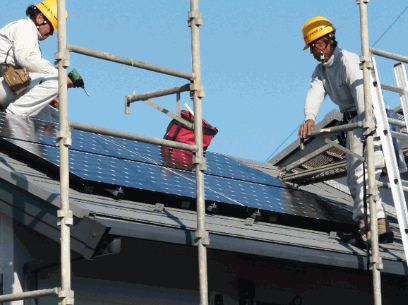If you're planning essential roof repairs, roof cleaning, or maintenance, you may be asking yourself whether you are legally obliged to use scaffolding or not. After all, it would add to the expense and increase the time taken to complete the job. So, is scaffolding absolutely necessary, or can you skip this step and get straight to work?
As a leading scaffolding hire company in the North East & North Yorkshire regions, Scaffold Crew is here to give you a definitive answer!

Working on a roof, whether for minor repairs or extensive roofing projects, presents a significant risk to worker safety. As to whether it is actually illegal to work on a roof without scaffolding, we have to look at various safety regulations, safety guidelines, and risk assessment protocols to answer the question properly.
In this Scaffold Crew blog, we will explore the legality and safety measures required for roofing work, including domestic roofs, sloping roofs, and flat roofs.

In the UK, the Health and Safety Executive (HSE) outlines specific safety standards and legal requirements for roofing work. According to these regulations, it is not strictly illegal to work on a roof without scaffolding, but doing so without proper precautions and fall protection measures can lead to severe consequences, including civil claims and prosecution.
The working-at-height regulations apply to any height at which a fall could cause injury. This means that the regulations apply, whether the work is taking place at 1 metre or 20 metres!
Compliance with these safety regulations is essential to ensure that all roofing activities are conducted safely and legally. Ignoring these guidelines not only puts workers at risk of injury but also exposes employers and property owners to legal and financial liabilities.
While it's not technically illegal to work on a roof without scaffolding, you are expected by law to take necessary safety measures. And one of the best methods is to erect scaffolding.
There are a few exceptions, but scaffolding is a wise choice in most cases.
So, how do you know whether you need scaffolding?
Any roof project should start with a proper risk assessment!
A proper risk assessment is crucial before commencing any roofing job. Assessing risks helps identify potential hazards, such as fragile roof surfaces, falling objects, and electrical hazards. For fragile roofs, which require particular attention, appropriate safety measures must be taken to prevent accidents.
This includes the use of crawling boards and ensuring the structural integrity of the roof surface. Additionally, it's important to consider weather conditions that might affect the safety of the roofing job. High winds, rain, or snow can create slippery surfaces and increase the risk of falls. Regularly inspecting and maintaining the roofing materials and equipment can also help in mitigating risks associated with the job.
Erecting sturdy scaffolding creates a safer environment and reduces the chances of accidents, falls, and injuries. This is where the Scaffold Crew excels, providing high-quality scaffold structures that won't let you down.
Discover: How Often Does Scaffolding Need To Be Inspected

For most roof work, especially those involving significant height, using scaffolding or other suitable equipment like safety nets slung beneath the roof is essential to protect workers. Edge protection, such as guard rails, is also crucial to prevent falls from roof edges. It also stops equipment or materials from falling from the roof.
Safety harnesses and fall restraint systems are necessary for tasks performed at height, ensuring that workers can conduct roof repairs or roofing projects safely.
In addition to these measures, it's important to implement comprehensive training programs for workers to ensure they are familiar with using all safety equipment properly. Regular safety drills and checks can further enhance preparedness and reduce the likelihood of accidents.
Finally, clear signage and barriers should be placed around the work area to alert others to the ongoing roofing activities, thus minimising the risk of accidental intrusions that could lead to injuries.
UK regulations vary for different types of roofs, so it's worth checking these out...
Working on flat roofs may seem less hazardous compared to sloping roofs, but safety precautions are still vital to ensure worker safety. The use of guard rails around the perimeter of the roof is highly recommended to prevent accidental falls. Safety harnesses should also be employed, particularly when workers are near the roof edges or if there are any openings in the roof. Additionally, it is important to ensure that the surface of the flat roof is kept clear of debris and that any materials or equipment are properly secured to prevent tripping hazards.

A sloping roof poses additional risks due to the angle of the surface, which can make it more difficult for workers to maintain their balance. Proper fall protection measures, such as scaffolding or safety nets slung beneath the work area, are required to mitigate these risks. In addition to these measures, workers should use roof ladders or crawling boards to provide stable footing. Safety harnesses and fall arrest systems are crucial for protecting workers from serious injuries in the event of a fall. It is also essential to inspect the roof for any loose or damaged tiles that could contribute to slips or falls.

For terraced properties, the close proximity of adjacent buildings presents unique challenges. Edge protection, such as guard rails or temporary barriers, is necessary to prevent falls from the roof. Secure access points, such as scaffold towers or temporary staircases, should be provided to ensure safe and easy access to the roof. Workers must be trained to navigate the narrow spaces between buildings safely, and extra caution should be taken to avoid disturbing neighbouring properties. Additionally, ensuring that all materials and tools are properly secured can prevent them from falling and causing injuries to workers or pedestrians below.
By following these specific guidelines for different roof types, employers can create a safer work environment, reducing the risk of accidents and ensuring that roofing projects are completed efficiently and safely.
Delve into: Can A Neighbour Refuse Access For Scaffolding

Most roofing contractors don't own their own scaffolding! They hire scaffolding from professionals, like the Scaffold Crew. Also, it's against the law for an unlicensed person to erect and dismantle scaffolding!
While DIY roofing repairs might save money, they come with increased safety risks, particularly if you lack the proper equipment or knowledge of safety guidelines. Without the right experience, you might overlook critical safety measures such as securing a stable ladder, using a safety harness, or implementing proper fall protection. Additionally, DIY repairs can lead to substandard work that may not adhere to building regulations, potentially resulting in further damage and higher long-term costs.
Hiring qualified professionals ensures that proper risk assessments are conducted, identifying and mitigating potential hazards effectively. These professionals have the expertise to use the most suitable equipment, such as scaffolding, guard rails, and safety nets, significantly reducing the potential risks associated with roofing repair.
Check out: How Much Is Scaffolding And How Is Scaffolding Charged
They also possess the skills to handle complex roofing issues that might be beyond the capability of an amateur, ensuring that repairs are completed to a high standard and in compliance with safety and building regulations.
Moreover, professional roofers are typically insured, providing an additional layer of protection for both the workers and the property owner in case of accidents or damage during the repair process. This professional approach not only enhances safety but also provides peace of mind, knowing that the roofing project will be done correctly and safely.

Compliance with UK safety standards is not just about legality but about ensuring that every roofing job is completed safely and efficiently. Following these standards helps protect workers from potential hazards, ensuring that they operate in a safe environment.
Local authorities may inspect construction work to ensure adherence to safety regulations, and failure to comply can result in serious safety breaches and legal repercussions. These consequences can include hefty fines, work stoppages, or even criminal charges for gross negligence.
In addition to avoiding legal issues, following the regulations encourages a culture of safety within the workplace. It demonstrates a commitment to the well-being of employees and contractors, which can improve morale and productivity. Companies that prioritise safety and mitigate risks are also more likely to attract skilled workers who value a safe working environment.
Furthermore, following safety rules can reduce the likelihood of accidents, which can be costly and time-consuming. Accidents often lead to project delays, increased insurance premiums, and potential compensation claims. By ensuring compliance, companies can mitigate these risks, resulting in smoother project execution and financial savings.
Ultimately, compliance with safety regulations is essential for protecting workers, maintaining legal standing, and promoting a positive and productive workplace. It underscores the importance of safety in all aspects of roofing work, from minor repairs to major construction projects, ensuring that all activities are carried out responsibly and professionally.

So, we've established that working on a roof without scaffolding is not exactly a legal requirement, but neglecting appropriate safety measures can lead to serious injuries and legal consequences.
For this reason, we can say that scaffolding is necessary for most roofing jobs.
You are expected to take proper precautions when working on a roof, and erecting scaffolding is one of the best methods of creating a safe workspace.
If you're simply replacing a roof tile or two, or maybe cleaning out a gutter, you may be able to use ladders. Even so, ladders have their own set of safety rules, and it's vital that you use these to do the job safely.
Work on fragile roof surfaces requires extra care and precautions to prevent falls, and scaffolding is a must. This allows easier handling of materials and equipment and provides a stable working platform.
In the end, it's important to always prioritise worker safety by conducting thorough risk assessments, using approved fall protection, and following safety regulations. Whether for minor work or major repair projects, protecting workers and preventing accidents should be the top priority.
As the Scaffold Crew says; a safe roofing job is a successful roofing job!




